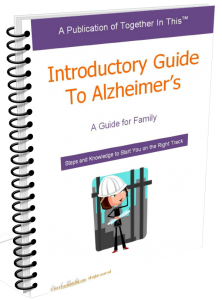The Alzheimer’s Podcast:
Keeping Them Home Longer, Safer, and Happier
Hello everybody, I’m Mike Good the founder of Together in This, an online resource helping Alzheimer’s and Dementia Caregivers Succeed.
Welcome to episode 22 of The Alzheimer’s Podcast.
As always, thank you for joining me today to listen to this podcast where my goal is always to empower you to maintain a positive experience, reduce and eliminate the need for medications, and make your time together with those you care for, the best it can be.
The podcast is no longer being produced or hosted on podcast platforms. But you can listen to or download the episode by clicking the text below:
Click this text to open a new window where you can play the audio or click the 3 dots to Download
Prefer Video? Watch Here:
Show Notes:
In this episode, I help you take a look at whether your home is contributing to undesirable dementia behaviors, and undermining your actions, and possibly speeding up their decline.
We want to create a Dementia Friendly Home where you can keep your loved one home longer, safer, and happier.
It won’t be easy and it’s definitely going to take a lot of hard work, but the dividends are huge.
If together we put strategies in place and make physical changes to your home environment, we can ease the strain, makes things better for the entire family, and possibly slow any decline.
Everyone involved in dementia care is at risk for mental and physical decline – the disease progresses, your health declines, and your relationships with your loved one and others is also at risk for decline.
Our behavior is typically a result of our environment including the people around us.
For people with dementia, whether it’s Alzheimer’s disease or another type of cognitive impairment, it’s no different.
However, the way their brains process and responds to sensory input is not always within their control.
Now couple this with the fact that our homes already don’t meet our needs – especially, when we have age related challenges such as dementia.
It creates failure and frustration. It creates negative emotions. And often times, it results in negative behavior from anyone – not just someone with dementia.
Once the person with dementia is exhibiting an undesirable behavior or emotion, it generally takes a great amount of empathy and skill to alleviate the situation.
So the ideal situation is to avoid the issue in the first place.
Start by putting yourself in their shoes – how would you feel if someone was preventing you from doing something or you couldn’t find something?
In additional to having compassion for why they feel a certain way, you can start making improvements to the home to better meet their changing needs.
Remove dangerous items so they are free to move about without risk of harm. Give them the opportunity to accomplish tasks with little to no assistance.
When needed – silently assist them by helping them without pointing out what you are doing. And at no time do you ever point out a deficit they may be experiencing.
Keep them involved and engaged – avoid boredom.
Remember, it’s likely something in the environment that has triggered a behavior.
Observe the individual’s surroundings.
Pay attention to noises, sounds, air temperature, people, and the demeanor of those around them – this includes all caregivers, including yourself.
Behaviors often repeat in dementia care, so keep a log of what you’ve observed.
Taking the time to understand how the environment is affecting the person with dementia is essential to creating what I call a dementia friendly home, where triggers have been minimized. And hopefully undesirable emotions and behaviors can be avoided.
This episode which was derived from my signature course – Adapting Your Home for Dementia.
In this course and other trainings I have, I talk about the 4 elements of the home to focus on:
These include:
Safety
Function
Stimulation
Triggers
These four elements work together to create a Dementia Friendly Home where you can keep your loved one home longer, safer, and happier.
Be sure to listen to the episode to learn more.
- Person Centered Profile with Example
- TinT Checklist: Is My Home Dementia Ready?
- TinT Featured Article:
Create a Happy and Safe Environment with Simple Improvements to the Home
- TinT Resource Page:
Creating an Alzheimer’s and Dementia Friendly Home
- TinT Signature Course:
Adapting Your Home for Dementia Course
- Cameras
- Trackers
- Clocks
- Electronic Reminders
- Retro Music Players
- Sensors and Alarms
- Stimulation and Enrichment
Please feel free to ask questions or leave a comment below:





Leave a Reply